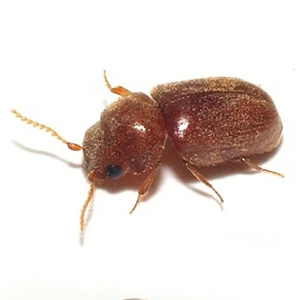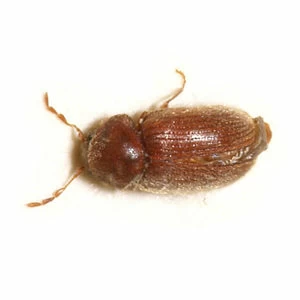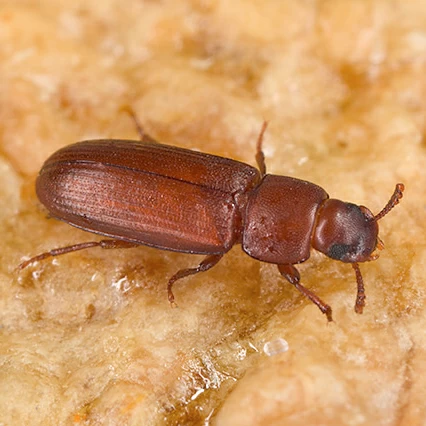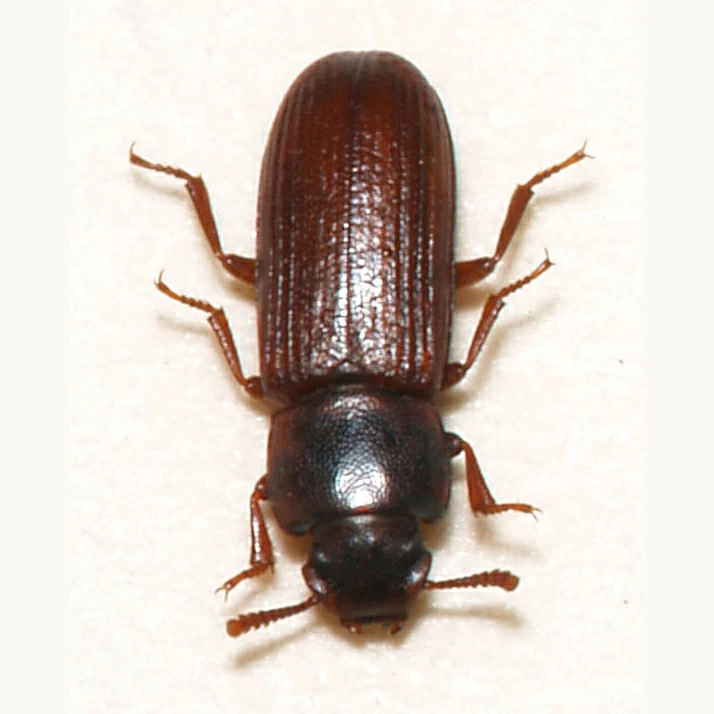


Bugging
You?
Stored Product Pests
Usually, the first sign that you have a stored product pest infestation is the appearance of small beetles around kitchen cupboards, flying moths, or light-colored larvae crawling near cracks and crevices of kitchen cupboards or across ceilings. Unfortunately, you purchased a product at the store from a manufacturer that packaged the stored product pest into their product. All dried food products in your pantry are susceptible, including birdseed, dry flower arrangements, and dry pet foods.
The solution to eliminating the threat requires locating all infested products and discarding them, general cleaning of infested areas, thoroughly vacuuming shelves using a crevice attachment to clean cracks, and placing your food products in sealed plastic containers. Let our experienced professionals handle these pests to ensure your family’s food safety and health. Call our pest exterminators at Apex today for a customized natural treatment plan.
Stored Product Pests Identification
The first step in pest control is identification. The Indian meal moth, saw-toothed grain beetle, cigarette beetle, drugstore beetle, red flour beetle, and confused flour beetle are fairly common store product pests you may encounter.

Indianmeal Moths
Identification Tips:
- Color: Front wings are bi-colored; the inner 1/3 attached to the body is whitish-gray, and the outer 2/3 is coppery or bronze. The hind wings are pale gray.
- Legs: 6
- Size:1/4 to 3/8 inches long with a wingspan of about 5/8 to 3/4 inches long
- Identifying Characteristics: Easily identified from other grain pests by peculiar markings on forewings (gray where attached to body and bronze with copper luster on back two-thirds)
Characteristics of this insect:
- This insect is a troublesome pest of stored grains and can be found feeding on grains, grain products, birdseed, dried fruits, nuts, cereals, and a host of other dry products
- Loosely clinging webbing on the grain is characteristic of this pest
- Mature females lay 100 to 300 eggs on food material, either singularly or in groups of twelve to thirty. Newly hatched larvae are small enough to pass through a sixty-mesh screen. Hence, excluding larvae from most packaged foods and grains is challenging.
- Adults emerge in four to thirty days, mate, and females lay the next generation’s eggs. Adults live from five to twenty-five days.

Saw-toothed Grain Beetle
Identification Tips:
- Color: Brown
- Legs: 6
- Size: 1/8 inch long
- Identifying Characteristics: 6 teeth located on each side of prothorax; flattened body; well-developed wings, but cannot fly.
Characteristics of this insect:
- They are often confused with not-so-common merchant grain beetle. This insect is commonly found in stored grain, rice, and packaged dry foods.
- Females lay between 43 and 285 eggs, which are dropped loosely among grain kernels or into a crevice of the seed. Eggs will hatch within three to five days based on optimal environmental conditions. Cocoons are constructed by joining pieces of grain; total development from egg to adult is three to four weeks.
- Adults live an average of six to ten months but may live up to three years if environmental conditions are favorable.
- Broken kernels are the preferred food, although they may feed on sound kernels. Mold may begin to grow on seeds, reducing the food source’s quality and value.

Cigarette Beetle
Identification Tips:
- Color: Yellowish-to reddish-brown
- Legs: 6
- Size: 1/10 inch long
- Identifying Characteristics: Oval-shaped; head bent downward sharply (humpbacked appearance); wing covers are smooth with antennal segments uniform and saw-like.
Characteristics of this insect:
- Cigarette beetles commonly infest dried tobacco and tobacco products. They also infest a host of dry food products and may damage the leaves and bindings of books when feeding on the paste or overstuffed furniture when invading the straw, hair, etc.
- Cigarette females lay about 30 eggs in three weeks.
- The cigarette beetle life cycle lasts 70 to 90 days, with perhaps 5 to 6 overlapping generations per year in warm localities, with only one generation per year in more temperate regions.
- Cigarette adult beetles are strong fliers.

Drugstore Beetle
Identification Tips:
- Color: Reddish-brown
- Legs: 6
- Size: 1/10 inch long
- Identifying Characteristics: Head deflexed (no distinct humpbacked appearance); wing covers have faint lines running lengthwise with antennae having three enlarged segments at the tip.
Characteristics of this insect:
- Drugstore beetles feed on many drugs in the pharmacy, such as laxative teas and strychnine. They also infest a host of dry food products
- Drugstore females lay eggs singly in foodstuffs
- The drugstore beetle life cycle requires seven months, with perhaps four generations per year in warm localities with only one generation per year in cooler climates.
- The drugstore adult beetle can fly and is attracted to light sources.

Red Flour Beetle
Identification Tips:
- Color: Reddish-brown
- Legs: 6
- Size: 1/8 inch long
- Identifying Characteristics: Red flour beetle antennae terminate in an abrupt, 3-segmented club
Characteristics of this insect:
- Have been found in barley, breakfast cereals, corn meal, crackers, oats, rice, wheat and wheat bran, flours, spices, sunflower seeds, pet foods, birdseed, and a host of other dry products
- Females lay between 300 -400 eggs over five to eight months
- The life cycle requires 7 to 12 weeks, and the adult can live three years or more
- Red flour beetles can fly short distances

Confused Flour Beetle
Identification Tips:
- Color: Reddish-brown
- Legs: 6
- Size: 1/8 inch long
- Confused flour beetle antennae segments increase in size gradually from base to tip.
Characteristics of this insect:
- Have been found in barley, breakfast cereals, corn meal, crackers, oats, rice, wheat and wheat bran, flours, spices, sunflower seeds, pet foods, birdseed, and a host of other dry products
- Females lay between 300 -400 eggs over five to eight months
- The life cycle requires 7 to 12 weeks, and the adult can live three years or more
- The confused flour beetle does not fly
*Image courtesy of Udo Schmidt. Licensed under Creative Commons 2.0.
**Image courtesy of the author Sarefo (Own work) [GFDL, CC-BY-SA-3.0 or CC BY-SA 2.5-2.0-1.0], via Wikimedia Commons
